Industrial Interior Design Style
Industrial interior design style is characterized by its unique blend of raw and contemporary elements that have gained popularity for their distinctive charm. This style celebrates the beauty of exposed brick walls, steel beams, and concrete floors, creating a rugged yet sophisticated ambiance inspired by old factories and industrial spaces. Focusing on functionality and minimalism, industrial design is perfect for infusing a chic, urban feel into living spaces. By incorporating metal accents, reclaimed wood, and vintage furniture pieces, this design style adds character and warmth to any room.Key Characteristics of Industrial Style
- Raw Materials: Industrial design features the use of raw materials such as exposed brick, concrete, and metals like steel and iron.
- Neutral Color Palette: Neutral hues like grey, black, and white dominate industrial interiors, creating a modern and sleek look.
- Open Spaces: Embracing the concept of open floor plans, industrial design promotes spacious and uncluttered interiors.
- Mix of Textures: Combining textures like distressed wood, metal finishes, and leather upholstery adds depth and visual interest.
- Industrial Lighting: Industrial-style lighting fixtures like pendant lights, exposed bulbs, and metal lamps enhance the overall aesthetic.
- Utilitarian Furniture: Furniture pieces in industrial style are often functional, featuring clean lines, metal frames, and a mix of materials.
- Vintage Accents: Incorporating vintage or retro decor elements adds a nostalgic charm to industrial interiors.
Industrial Style in Home Decor

Building on the allure of industrial interior design, characterized by its fusion of raw and contemporary elements, this style continues to captivate with its unique charm. The incorporation of exposed brick walls, steel beams, and concrete floors sets the tone for a rugged yet sophisticated ambiance inspired by the aesthetics of old factories and industrial spaces.
In industrial style home decor, exposed pipes and ducts play a pivotal role in creating an authentic industrial look. They inject a sense of raw, unfinished beauty into the space, reminiscent of old warehouses and factories. Opting to keep these elements visible can add an industrial edge to the design scheme, offering a nod to the style’s roots in utilitarian spaces.
The marriage of metal and wood is a defining feature of industrial design. The contrast between the sleek metallic surfaces and the natural warmth of wood creates a visually striking aesthetic. Steel, iron, and aluminum are commonly used for furniture and fixtures, complementing the organic feel of reclaimed wood. This combination adds depth and texture to the overall decor, highlighting the industrial sensibility of the space.
Industrial style embraces open floor plans and ample natural light, often achieved through large windows that allow sunlight to flood the space. The concept of uninterrupted flow and airy environments characterizes industrial design, creating a sense of spaciousness and connectivity within the living areas. Large windows not only enhance the industrial aesthetic but also emphasize the harmonious integration of interior and exterior elements.
Furniture and Accessories for Industrial Spaces

In industrial interior design, statement pieces play a crucial role in defining the space. These bold and eye-catching items serve as focal points that reflect the industrial aesthetic. Examples of statement pieces for industrial spaces include oversized metal lighting fixtures, industrial-style leather sofas, and large vintage factory gears repurposed as décor. Incorporating these unique pieces adds character and visual interest to the space, enhancing its industrial charm.
Lighting is a key element in industrial interior design, contributing to the overall ambiance of the space. Industrial spaces often feature a mix of ambient, task, and accent lighting to create a layered and dynamic environment. Pendant lights with exposed bulbs, metal finishes, and geometric shapes are commonly used to enhance the industrial look. Wall sconces made of industrial materials like wrought iron or brass can also complement the style. These lighting fixtures not only illuminate the space but also add a touch of industrial flair to the decor.
Industrial interior design style offers a unique blend of raw and contemporary elements, creating a functional and minimalist ambiance inspired by old factories. From exposed brick walls to steel beams and concrete floors, this style has evolved to fit modern urban interiors seamlessly. The integration of textures, materials, furniture, and accessories plays a crucial role in maintaining the industrial vibe while balancing functionality and aesthetics. By combining industrial design with other styles, one can achieve a cohesive and personalized look. Overcoming challenges such as creating warmth with lighting and wood accents, as well as addressing acoustics in open spaces, are key considerations in achieving comfortable and functional industrial-inspired interiors.
